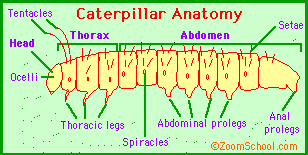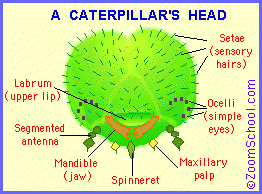
A caterpillar is the larval stage of butterflies and moths. This stage usually lasts from about two weeks to a month, and is the longest life stage for many lepidoptera (butterflies and moths). During this stage, the caterpillar can grow in size more than 30,000 times.
Caterpillars have a segmented body consisting of a head, a thorax (with three pairs of jointed legs with hooks), and an abdomen (usually with five pairs of stumpy prolegs). Its primary function is to eat and grow in preparation for pupating.
Eating, Tasting, and Smelling
The caterpillar will spend most of its time eating, and has powerful jaws that will serve this purpose. These well-developed jaws (mandibles) have very sharp cutting surfaces that easily chop leaves. The mandibles bite off plant material and tear it into small, easily digestible pieces. Underneath the mandible are the two maxillae, smaller mouth parts that guide the food into the mouth. The caterpillar holds onto the food with its thoracic legs.
The maxillae also have taste cells; these chemical detectors tell the caterpillar to eat when the food is appropriate, and not to eat when the food is not appropriate. The tiny
antennae, which are near the mouth parts, sense smells.
Caterpillars are very limited in their diet; many species will only eat the leaves of a single type of plant.
DigestionMost of a caterpillar's body is filled with intestines that quickly digest its food. Since the caterpillar is growing amazingly quickly and must also store enough food energy to fuel its pupal stage, digestion nourishment is a primary function.
Cells, Growth, and Imaginal DiscsUsually when organisms grow and develop, the number of cells in their body increases. This is NOT so with caterpillars. The newly hatched larva has the same number of cells as the large caterpillar which is ready to
pupate.
For the most part, the cells that comprise the caterpillar are not the cells that will become the adult (butterfly or moth). The caterpillar has
imaginal discs within its body. Different clusters of these cells will develop into different adult body parts. For example, one cluster will develop into the adult's compound eyes.
Molting and InstarsAs caterpillars grow, their exoskeleton becomes tight on them, so they molt (lose their old exoskeleton). Ecdysone is the molting hormone of insects. It causes an insect to molt.
After the molt, while the new skin is still soft, they swallow a lot of air, which expands their body. Then, when the cuticle hardens, they let the air out and have room for growth. Caterpillars
molt four or five times as they grow. Each different caterpillar stage is called an instar.
Coloration 
The Monarch caterpillar is brightly colored and is poisonous. |
Caterpillars come in many colors and patterns. Many caterpillars are camouflaged to blend into their surroundings (the
host plant), thus hiding them from predators. Generally, the brightly colored larva are poisonous; their color is a reminder to predators about their toxicity.
Protection from predatorsCaterpillars are soft bodied and slow moving. This makes them easy prey for predators, like birds, wasps, and mammals to mention just a few. Some caterpillars are even eaten by their fellow caterpillars (like
Zebra swallowtail larva which are cannibalistic).
In order to protect themselves from predators, caterpillars use different strategies, including:
- Poison Some caterpillars are poisonous to predators. These caterpillars get their toxicity from the plants they eat. Generally, the brightly colored larva are poisonous; their color is a reminder to predators about their toxicity. Some poisonous caterpillars include the Monarch and the Pipevine Swallowtail.
- Camouflage Some caterpillars blend into their surroundings extraordinarily well. Many are a shade of green that matches their host plant. Others look inedible objects, like bird droppings (the young Tiger Swallowtail larva).
- Eyespots Some caterpillars have eyespots that make them look like a bigger, more dangerous animal, like a snake. An eye spot is a circular, eye-like marking found on the body of some caterpillars. These eyespots make the insect look like the face of a much larger animal and may scare away some predators.
- Hiding Some caterpillars encase themselves in a folded leaf or other hiding place.
- Bad smells Some caterpillars can emit very bad smells to ward off predators. They have an osmeterium, an orange, y-shaped gland on their neck which gives off a strong, unpleasant odor when the caterpillar is threatened. This keeps away dangerous wasps and flies that try to lay eggs in the caterpillar. Many swallowtails have an osmeterium, including the Zebra Swallowtail.
LegsCaterpillars have two types of legs which perform different functions.
- Thoracic legs: Caterpillars have three pairs of jointed legs with hooks; these are attached to their thorax. Caterpillar's thoracic legs hold onto its food.
- Prolegs: The prolegs are stumpy legs that let the caterpillar climb very well, even up vertical surfaces. Caterpillars usually have five pairs of stumpy prolegs on the abdomen. These prolegs have crochets (small grasping hooks) on them. The last pair of prolegs are called anal prolegs; they are at the very end of a caterpillar's abdomen (hind region). These prolegs disappear in the adult.
LocomotionA caterpillar moves in a rippling fashion. It contracts the muscles in its rear segments, pushing blood into the forward segments, which lengthens the front part of the body. The legs hold onto the forward position and then the front muscles contract, pulling the rear segment forward.
BreathingSpiracles are an insect's breathing pores. They are usually located on the thorax and abdomen.
SightCaterpillars have six pairs of simple eyes (ocelli). Ocelli (also called stemmata) are small, simple eyes that can detect changes in light intensity, but cannot form an image. Ocelli are composed of photoreceptors (light-sensitive cells) and pigments. Ocelli are usually located in two clusters of six eyes on the sides of a larva's head.
Sense of TouchCaterpillars sense touch through tiny hairs (
setae) that are all over the caterpillar's body. These tactile hairs grow through holes in the
pinaculum (dark, flattened plates on a caterpillar's body) of the
exoskeleton. These hairs are attached to nerve cells, and relay information about touch to the insect's brain.
A chalaza (pl. chalazae) is a raised sclerotized (hardened by scleroproteins) portion of the
cuticle of a caterpillar that bears one to four
setae (tactile hairs); each seta arises from a separate raised area.
The tentacles are also sense touch.
Silk Production
A spinneret is a tube-like structure on a larva's lower lip (labium) that contains the spinning apparatus (the silk glands) of the larva. The caterpillar draws silk (which is made in the salivary glands) from a tube in the spinneret. The silk dries when exposed to the air. Caterpillars use this silk to support themselves and to make webs and cocoons
Life Span
Most caterpillars live from about two weeks to a month. For many lepidoptera, this is the longest part of the life cycle.
 Free Forum Hosting
Free Forum Hosting